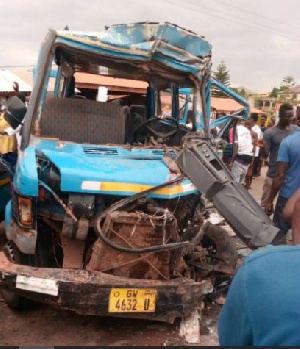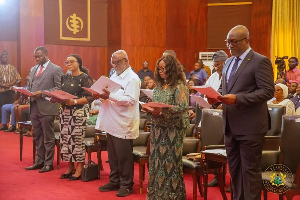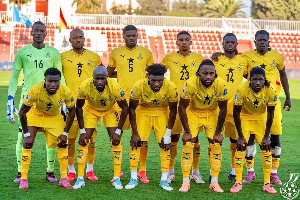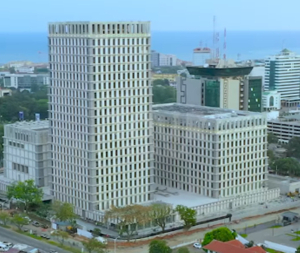About 90 percent of causes of road traffic crashes can be attributed to human error. These errors are manifested in many negative road user behaviours including speeding, drink driving, talking on mobile phone while driving, wrongful overtaken and other many indiscipline driving attitudes on our roads.
I can go on and on to name more negative road user behaviours which have contributed to the recent spate of high road traffic crash fatalities and injuries cases in the country.
However, speeding remains one major underlining factor that comes to play in all the other forms of causes of crash cases. What this means is that speeding has a means to contribute to the other related cases of road crashes and acts as the fuel to many of them.
For instance, there is a slim chance of a car on a top speed preventing a crash from happening, whereas a driver driving on the normal speed limit, though might wrongfully overtake, can still manage the issue and save any further crash. From these analogies, speed is the catalyst on which many other bad road attitudes ride to cause havoc on our roads.
One may even ask “what is the required limit to say speed is too much?” Giving some definitions would help to make us understand what it means when we say speeding in road safety perspective.
A coat in the “Australia Speeding Statistics Bibliography” defined Speeding as when a driver or rider runs a desired or specific legal limit “insensibly” and do it for prolonged periods.
The” Concise Oxford English Dictionary”, Thumb Index Edition also defined speed as in the case of a motorist travel at a speed greater than the legal limit.
The same dictionary defined speed limit as the maximum speed at which a vehicle may legally travel on a particular stretch of road. From all the definitions, the underlined word was legal limit. It means that speeding on our roads has a certain limit which is required of a motorist to run so once a driver exceeds this limit it is considered as illegal and must be treated as an offense.
“If you are speeding, you are not only breaking the law but putting yourself and others including locals in danger of your “insensible” acts ( The Australia Speeding Statistics Bibliography).
The document mentioned speeding as a big thing in Australia and acts approximately 40 percent of the deaths caused by road traffic crashes. Speeding, therefore, is a global phenomenon contributing to many road crashes and fatality cases. It is of no wonder that currently road safety is mentioned as being a public health issue due to the magnitude of the road traffic causalities across the globe.
This requires that some bad road habits such as speeding would have to be fought against to clamp down the negative effect its contributing to the crashes cases in the country.
THE SITUATION IN GHANA
Bringing the discussion home, statistics available to the National Road Safety Commission (NRSC) show that Speeding is the major contributor to the many crashes and fatalities on our roads. speeding is said to cause 38 percent of pedestrian knockdowns, deaths and injuries. This same speed accounts for 17 percent of passenger death and injuries, motorcycle related crashes and casualties, wrongful over takings and head-on collisions, tyre burst related crashes and causalities and run-offs and somersaulting.
There are many causes of why motorists speed, among them, notably are fast running vehicles, roads getting smoother and wider and simply human being getting more crazier. These happen everywhere, in our town, on the highways, on rural roads and at the villages. Motorists speeding do not have any boundary. Once there is an access that promotes speeding drivers just enjoy themselves. In Ghana speeding contributes to 60 percent of all fatal crashes. Whenever there is a crash due to speeding the vehicle transfers the speed to the occupants and if not restrained by seatbelt or strong seats, an occupant may be thrown within or outside the vehicle or hit body against each other or broken metals in the vehicle or loose objects. Pedestrians, Motorists and Passengers account for nearly 70 percent of the traffic causalities. This situation is often the consequence of speeds especially in urbanized environments by drivers.
This year 2017, from January to April 30, there have been 4,049 crashes out of which 708 persons killed, 3,983 injured, 1,199 being pedestrian knockdowns, 6,468 vehicles involved and 1,289 motorcycles involved. This is how bad the situation is, more so, when Ghana is to lose 1.6 percent of its Gross Domestic Products (GDP) again this year, as a result, these casualties. APPROVED SPEED LIMITS About the 70 percent road traffic casualties, majority of these cases happen in the urbanized areas. This stems largely from the fact that the roads in the urban centers are very smooth and wide which encourages speeding. However, there are well-approved speed limit at various levels which are to ensure that every vehicle is within the approved limit when in motion. It does not mean with these limits enforcement, there are no issues of crashes. There are but the rate at which it occurs and even if it does, the effect can be managed. As contained in the National Speed Limit Law, maximum urban speed limit should be 50 km/h, while maximum rural speed limit is 90 km/h and the for the Motorway speed limit is 100 km/h.
These laws are statutory and cannot be modified. The question, however, is how is the law being enforced and to what extent. Enforcement remains one big aspect to ensure these laws are complied with.
WHAT HAS BEEN DONE BY AUTHORITIES ON THE INTERNATIONAL FRONT
May 8th of every year has been set aside by the West Africa Road Safety Organization (WARSO) to be observed by member countries to celebrate the Anniversary and Inauguration of the Association.. Celebrating its 9th Anniversary the Organization made a call on it 15 member countries to place emphasize on speeding due to the relative rising fatalities, for which the National Road Safety Commission (NRSC) as the lead Road Safety Agency in Ghana lead the observation of the WARSO Day celebration unveiling a speed campaign on the slogan: “Save Lives: #Slow Down.”
Ghana as part of the United Nations (UN) and an Implementing country of the UN Decade of Action, a document of which it is a signatory that seeks to reduce road traffic crashes to 50 percent by the year 2020 which began in 2011 also joined member countries to observed the UN Global Road Safety Week. In its 4th Anniversary, the week came off from the 8th to 14th May, a way member countries were being encouraged to remain committed and focused on the target set in the Decade of Action document. WARSO has adopted the UN Decade of Action as an Implementing working document in all it member states.
It was for this reason that this year, both WARSO and UN chose the same theme on speeding. The NRSC spearheaded the celebrations in the country by unveiling a campaign on the slogan: “Save Lives: #Slow Down”.
At the media engagement briefing in Accra, Ing. Mrs. May Obiri Yebaoh, the Executive Director of the NRSC said, 60 percent of all road fatalities were as a result of senseless speeding on the road and called for collective efforts by all stakeholders to curb the menace.
AT THE LOCAL LEVEL
In Ghana, although the week was observed throughout the Nation, the NRSC selected the Accra-Winneba-Mankessim-Cape Coast road where officials of NRSC Head Office and the Central Regional Office collaborated with it Implementing Agencies, Motor Traffic and Transport Department (MTTD) of the Ghana Police and the Driver Vehicle Licensing Authority (DVLA) to embark on a Speed Enforcement and Outreach Exercise. The four set of teams deployed to cover the designated areas were equipped with speed radar guns to check the speed of motorists to ensure enforceability of the law.
NRSC advocates were on the other hand, educated drivers, passengers, and pedestrians on good road practices. The exercise was simultaneously embarked on in other regions that traffic road crashes are prevalent. THE WAY FORWARD The NRSC as the lead agency in the road sector charged with the mandate of coordinating all road safety activities has pledged to remain dedicated to it campaigns and advocacy.
The Commission generally employs road user educational campaigns to help compliment other road safety measures in Ghana. The commission remains resolute to be louder and visible with its educational campaigns at both the National and Regional levels. This will be done through more education, publicity, advocacy, monitoring, and research.
Also, the commission will hit hard against the use of sub-standard vehicle tyres which began from June 2017 and the commencement of the National Towing Project to ensure the removal of disabled vehicles from the roads from July 2017. Another big move of the Commission is to get Authority or Agency status to ensure that Institutions comply with its road safety related standards. The Enforcement Agencies like the MTTD are also expected to be more visible and ensure greater compliance with speed regulations. They are also expected to adopt ICT based practices together with measures like spot fine and speed cameras compliance. Also, offenders are to be prosecuted.
There a call on the Engineering team of the Ghana Highway Authority, Dept of Urban roads and Department of Feeder Roads to build more traffic calming measures, signage, and markings especially the “zebra” crossings and construct more footbridges. There was also a call on the media to adopt wider reportage on road safety issues to create greater awareness.
Road crashes have dire consequences on households and the nation as a whole including incapacitation, destruction to property, loss of time etc. Road traffic crashes are a Public health as well as a developmental issue. If the productive force is attacked by road traffic crashes then the development of the country is under a serious threat.
All hands must be deck so we work tirelessly to ensure that the fight against speeding on our roads become a success. We need to kill speed before it kills us. Reduce the speed.
Your family is waiting for you. Think and drive! Stay Alive! Arrive Alive! Road Safety is a shared and collective responsibility!
Opinions of Friday, 9 June 2017
Columnist: Samuel Owusu-Yeboah
Let’s kill speeding before it kills us
Entertainment














